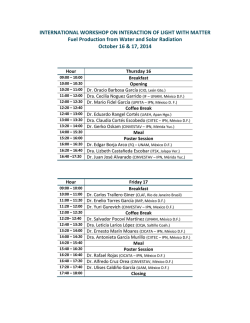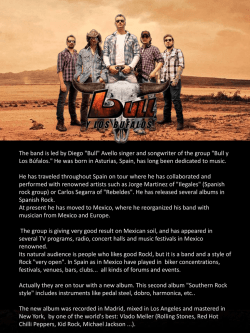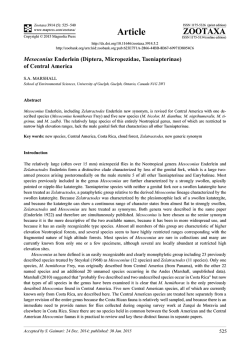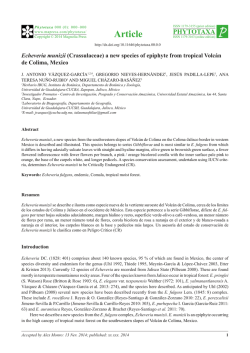
The first troglomorphic species of the genus
Zootaxa 3920 (3): 474–482 www.mapress.com /zootaxa / Copyright © 2015 Magnolia Press Article ISSN 1175-5326 (print edition) ZOOTAXA ISSN 1175-5334 (online edition) http://dx.doi.org/10.11646/zootaxa.3920.3.6 http://zoobank.org/urn:lsid:zoobank.org:pub:5DF7FF7C-3A5E-4BE2-8E20-D84934965817 The first troglomorphic species of the genus Phrynus Lamarck, 1801 (Amblypygi: Phrynidae) from Mexico ALI ABADALLAN GUZMÁN1, DANIEL CHIRIVI JOYA2 & OSCAR F.FRANCKE1 1 Colección Nacional de Arácnidos, Departamento de Zoología, Instituto de Biología, Universidad Nacional Autónoma de México. 3er. Circuito exterior s/n. Apartado postal 70-153, C.P. 04510, Ciudad Universitaria, Coyoacán, Distrito Federal, México. E-mail: [email protected] 2 Departamento de Zoologia, Instituto de Biociencias, Universidade de São Paulo. Rua do Matão, trav. 14, n° 321, Cidade Universitária, São Paulo- SP, CEP: 05508-090 Abstract A new troglomorphic species, Phrynus perrii sp. nov., is described from two adult females from Cueva del Naranjo, Municipio Cintalapa, Chiapas, Mexico. This is the first continental record of a troglomorphic Phrynus species, and the second troglomorphic species of the genus. With the description of this species, in Mexico there are ten extant species, plus one fossil of the genus Phrynus, and it is the seventh species of troglobitic whip spiders from Mexico, making it the country with the highest richness of amblypygids species worldwide. Key words: whip spiders, Phrynus perrii sp. nov., troglomorphic, Chiapas Resumen Se describe una nueva especie troglomórfica, Phrynus perrii sp. nov., con base a dos hembras adultas de la Cueva del Naranjo, Municipio Cintalapa, Chiapas, México. Este es el primer Phrynus troglomórfico continental y la segunda especie troglomórfica para el género. Con la descripción de ésta, en México hay 10 especies, más una especie fósil del género Phrynus, además es la séptima especie de tendarapos troglobios para México, siendo el país con la mayor riqueza de especies de amblipígidos en el mundo. Palabras clave: tendarapos, Phrynus perrii sp. nov., troglomórfico, Chiapas Introduction The arachnid order Amblypygi has a low number of species in comparison with other arachnids such as mites, spiders, scorpions or harvestmen. It comprises 158 species divided in five families and 17 genera, distributed in the tropical and sub-tropical regions of the world (Harvey, 2007). Amblypygi specimens are seldom collected, because they are predominantly nocturnal and often remain hidden in difficult to search places such as crevices among rocks, tree-trunks and logs, or are found in caves where they are hard to access, to observe, and collect (Weygoldt, 2000). Almost half of the species of amblypygids are known from caves, of these, the vast majority are troglophiles (Quintero, 1981; Cokendolpher & Sissom, 2001; Racovitza, 2006). In continental America, there are three of the five existing families: Charinidae is circum-tropical; Phrynichidae represented by a single genus in Brazil; and Phrynidae distributed exclusively in the Americas (except Phrynus exsul) (Harvey, 2003). Only Charinidae and Phrynidae have troglomorphic species in the new world, as is the case of Charinus Simon, 1892 “sensu lato”, Paraphrynus Moreno, 1940 and Phrynus Lamarck, 1801. One of the first troglobites known from the Americas are two species: Speleophrynus tronchonii Ravelo, 1975 and Speleophrynus bordoni Ravelo, 1977 from caves in Venezuela, presently in the genus Charinus. 474 Accepted by L. Prendini: 27 Jan. 2015; published: 23 Feb. 2015 Key to troglomorphic species of Phryninae: 1. 2. 3. 4. 5. 6. 7. - Dorsal margin of pedipalp patella with one spine between the two longest spines (Phrynus) . . . . . . . . . . . . . . . . . . . . . . . . . . . 2 Dorsal margin of pedipalp patella with two spines between the two longest spines (Paraphrynus) . . . . . . . . . . . . . . . . . . . . . . 3 Ocular tubercle reduced, with black pigmentation; chelicera with three teeth on external margin of retrolateral surface (Pinar del Rio, Cuba) . . . . . . . . . . . . . . . . . . . . . . . . . . . . . . . . . . . . . . . . . . . . . . . . . . . . . . . . . . . . . . . . . . . . . . . . . . . . . .Phrynus noeli Nearly obsolete ocular tubercle is the same color as the carapace (pale brown); chelicera with one or two teeth on external margin of retrolateral surface (Chiapas, Mexico) . . . . . . . . . . . . . . . . . . . . . . . . . . . . . . . . . . . . . . . . . . . . . . Phrynus perrii sp. nov. Median eyes reduced or absent, but at least lateral eyes present . . . . . . . . . . . . . . . . . . . . . . . . . . . . . . . . . . . . . . . . . . . . . . . . .4 All eyes entirely missing and lacking ocular tubercle (Yucatán, Mexico) . . . . . . . . . . . . . . . . . . . . . . . . . .Paraphrynus reddelli Median eyes reduced but present; ocular tubercle nearly obsolete . . . . . . . . . . . . . . . . . . . . . . . . . . . . . . . . . . . . . . . . . . . . . . . . 5 Median eyes and ocular tubercle absent (San Luis Potosí, Mexico). . . . . . . . . . . . . . . . . . . . . . . . . . . . . . . Paraphrynus velmae Pedipalp tarsus lacking such a dorso-lateral spine . . . . . . . . . . . . . . . . . . . . . . . . . . . . . . . . . . . . . . . . . . . . . . . . . . . . . . . . . . . .6 Pedipalp tarsus with a small dorso-lateral spine (Quintana Roo and Yucatán, Mexico). . . . . . . . . . . . . . Paraphrynus chacmool Pedipalp Fv1 spine slightly curved or only hook shaped at the apex . . . . . . . . . . . . . . . . . . . . . . . . . . . . . . . . . . . . . . . . . . . . . . 7 Pedipalp Fv1 spine straight (Tamaulipas, Mexico) . . . . . . . . . . . . . . . . . . . . . . . . . . . . . . . . . . . . . . . . . . . . Paraphrynus baeops Pedipalp Fv1 spine slightly curved full length; anterior edge of carapace strongly bilobed; basal segment of chelicera with one tooth on external margin of retrolateral surface (Tabasco, Mexico) . . . . . . . . . . . . . . . . . . . . . . . . . . . . . . . Paraphrynus chiztun Pedipalp Fv1 spine curved only of apex (hook shaped); anterior edge of carapace moderately bilobed; basal segment of chelicera with two teeth on external margin of retrolateral surface, the distal tooth slightly smaller and somewhat blunt (Oaxaca, Mexico) . . . . . . . . . . . . . . . . . . . . . . . . . . . . . . . . . . . . . . . . . . . . . . . . . . . . . . . . . . . . . . . . . . . . . . . . . . . . .Paraphrynus grubbsi Acknowledgments We would like to express our sincere thanks to Griselda Montiel-Parra, Gerardo A. Contreras-Felix and project “IN214114 (PAPIIT-DGAPA): Inventario de Argásidos (Ixodida: Argasidae) en cuevas de México. Huéspedes, distribución y relaciones filogenéticas” for collecting the types. We thank the CNAN-CNAC especially Jesús CruzLópez for all the help and assistance during the work, Luis F. de Armas for the information provided, Graciela Rivera for help in preparation of the map and Kaleb Zárate for information related to the cave. Thanks to Coordenação de aperfeiçoamento de pessoal de nível superior (CAPES), for providing the doctoral scholarship program PEC-PG n° 12476-13-7 to Daniel Chirivi. The specimens were collected under Scientific Collecting Permit FAUT-0175 issued to Oscar F. Francke by SEMARNAT, Mexico. Two reviewers and the Associate Editor contributed significantly to the improvement of our manuscript. Literature cited Armas, L.F.d. (2006a) Los amblipígidos o tendarapos de México (Arachnida: Amblypygi). Boletín de la Sociedad Entomológica Aragonesa, 39, 345–359. Armas, L.F.d. (2006b) Sinopsis de los amblipígidos Antillanos (Arachnida: Amblypygi). Boletín de la Sociedad Entomológica Aragonesa, 38, 223–245. Armas, L.F. (2012) Nueva especie de Paraphrynus Moreno, 1940 (Amblypygi: Phrynidae) de México y el suroeste de los EE.UU. de América. Revista Ibérica de Aracnología, 21, 27–32. Armas, L.F. (2014) Los Amblypygios de Cuba (Arachnida: Amblypygi). Revista Ibérica de Aracnología, 24, 29–51. Armas, L.F. & Perez, A. (1994) Description of the first troglobitic species of the genus Phrynus (Amblypygi: Phrynidae) from Cuba. Avicennia, 1, 7–11. Armas, L.F., Guzmán, A.A. & Francke, O.F. (2014) Nueva especie de Phrynus (Amblypygi: Phrynidae) de México. Revista Ibérica de Aracnología, 25, 03–07. Baptista, R.L.C. & Giupponi, A.P.L. (2002) A new troglomorphic Charinus from Brazil (Arachnida: Amblypygi: Charinidae). Revista Ibérica de Aracnología, 6, 105–110. Baptista, R.L.C. & Giupponi, A.P.L. (2003) A new troglomorphic Charinus from Minas Gerais state, Brazil (Arachnida: Amblypygi: Charinidae). Revista Ibérica de Aracnología, 7, 79–84. Ballesteros, J.A. (2006) Catálogo de amblypígidos, uropígidos y solífugos (Arachnida) de la Colección Nacional de Arácnidos (CNAN). Tesis de Licenciatura. Escuela Nacional de Ciencias Biológicas, Instituto Politécnico Nacional. México, D.F., 100 pp. Cokendolpher, J.C. & Sissom, W.D. (2001) A new troglobitic Paraphrynus from Oaxaca (Amblypygi: Phrynidae). Texas Memorial Museum, Speleological Monographs, 5, 17–23. Harvey, M.S. (2003) Catalogue of the smaller arachnid orders of the world: Amblypygi, Uropygi, Schizomida, Palpigradi, A NEW TROGLOMORPHIC PHRYNUS Zootaxa 3920 (3) © 2015 Magnolia Press · 481 Ricinulei and Solifugae. CSIRO Publishing. Collingwood, Victoria, Australia, 385 pp. Harvey, M.S. (2007) The smaller arachnid orders: diversity, descriptions and distributions from Linnaeus to the present (1758 to 2007). Zootaxa, 1668, 367–380. Oliveira, A.C., Giupponi, A.P.L. & Lopes, R. (2013) A new species of Charinus Simon, 1892 from northeastern Brazil with comments on the potential distribution of the genus in Central and South America (Arachnida: Amblypygi:Charinidae). Zootaxa, 3737 (4), 488–500. http://dx.doi.org/10.11646/zootaxa.3737.4.9 Quintero, D. (1981) The Amblypygid genus Phrynus in the Americas (Amblypygi, Phrynidae). Journal of Arachnology, 9, 117–166. Racovitza, E.G. (1907) Les problémes biospéologiques. Biospeleologica I. Archives Zoologiques Expé. et Géné., 6, 371–488. Racovitza, E.G. (2006) Essay on biospelological problems: French, English, and Romanian. [Facsimile of the publication Essai sur les problèmes biospèologiques (1907), translated by D. C. Culver & O. Moldovan] Institul de Speologie “Emil Racovitza”, Cluj-Napoca, Romania. [total page number unkown] Rowland, J.M. (1973) Two new troglobitic Amblypygida of the genus Tarantula from Mexican caves (Arachnida). Bulletin of the Association for Mexican Caves Studies, 5, 123–128. Shultz, J.W. (1999) Muscular anatomy of a whip spider, Phrynus longipes (Pocock) (Arachnida: Amblypygi), and its evolutionary significance. Zoological Journal of the Linnean Society, 126, 81–116. http://dx.doi.org/10.1111/j.1096-3642.1999.tb00608.x Volschenk, E.S. & Prendini, L. (2008) Aops oncodactylus, gen. et sp. nov., the first troglobitic urodacid (Urodacidae: Scorpiones), with a re-assessment of cavernicolous, troglobitic and troglomorphic scorpions. Invertebrate Systematics, 22, 235–257. http://dx.doi.org/10.1071/IS06054 Weygoldt, P. (2000) Whip Spiders (Chelicerata: Amblypygi) Their Biology, Morphology and Systematics. Apollo Books, Stenstrup, Denmark, 164 pp. 482 · Zootaxa 3920 (3) © 2015 Magnolia Press GUZMÁN ET AL.
© Copyright 2024




